Pipes for irrigation in the country: a comparative overview of different types of pipes
Buckets and hoses are used less and less when watering a country garden.Often, owners of plots in dacha areas prefer to make their lives easier by installing an irrigation system. And the question immediately arises of installing a garden water supply system designed to supply water to the beds and distribute it there.
We will tell you which irrigation pipes in your dacha are best to choose to build a trouble-free system. In the article we presented, we analyzed popular schemes and materials used in the construction of automatic irrigation. Technical characteristics and evaluation of all used varieties are given.
The content of the article:
Briefly about country irrigation systems
Irrigation of beds and fruit trees in the country using pipes can be organized in several ways. When choosing one system or another, you need to take into account the type of soil on the site, general climatic conditions and the desire (or unwillingness) to spend time watering the garden.
The manual method of moistening the soil is too labor-intensive. A country house is intended for relaxation. Often, city residents go to it on weekends to work there by the sweat of their brow. There are those who even really like this pastime.
But most just want to relax outside the city. However, almost everyone has a small vegetable garden, apple trees and currants in their dacha. And they need to be watered.
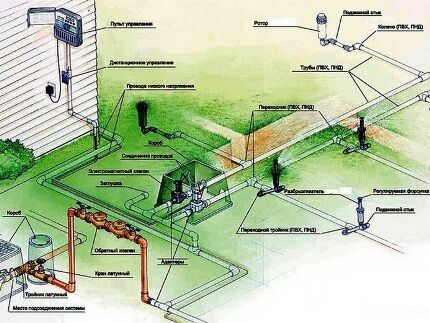
Based on the method of water supply, there are three types of non-manual irrigation systems:
- Drip surface.
- Subsurface.
- Sprinkling (sprinkling).
The technology for creating “artificial rain” is the most common. To install such a system in a summer cottage, it is necessary to install several rotary sprinklers and connect water pipes to them. However, such sprinklers waste too much water.
Some of it simply evaporates before reaching the soil. This type of country irrigation is mainly intended for watering large lawns.
Two other options for automatic watering systems involve supplying moisture to or onto the soil directly next to the plant being watered. For this purpose, perforated pipes, droppers and bubblers are used. This method of irrigation is more economical in terms of water consumption, but due to the large length of water pipelines it is more expensive to install.
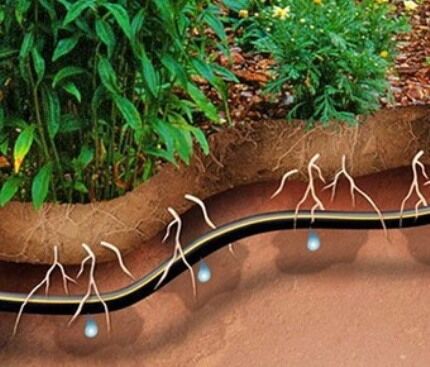
All details about the choice pipes for drip irrigation devices you will find in the article devoted to this interesting issue.
Pipes for all types of garden watering are selected according to diameter in the range from 25 to 32 mm. If the pressure in the central water supply at the dacha is low or water is supplied to the system from the tank by gravity, then the cross-section should be closer to the upper limit.Otherwise, you can save money by taking pipes and fittings with a diameter of 25–27 mm.
With smaller values, the pipeline will work ineffectively, watering the ground for too long. And with large sizes it will turn out to be an unnecessarily expensive pleasure. The flow of water will still only fill such a pipe halfway. And large-diameter pipe products are obviously more expensive than their thinner counterparts.
Rules and guidelines choosing a hose for wateringcultural plants and green spaces on a summer cottage are outlined in the article, which we recommend reading.
Features of metal water pipes
Products made from polymer compounds are now used everywhere. This material does not rust, is cheap and easy to install. But metal has not yet been written off either.
At domestic dachas you can find a lot of metal water pipes used for watering plantings on the site. In many ways, this is a legacy of the Soviet era, when polymer pipes simply did not exist. However, not everything is so simple; metal has a lot of advantages.
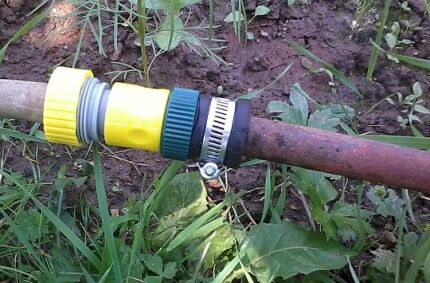
Among the advantages of metal irrigation pipes are:
- resistance to fractures;
- frost resistance;
- long service life of 20–30 years;
- high mechanical strength.
Metal water conduits can be safely laid under pedestrian paths and areas near the garage where vehicles are parked. They will not break under pressure from above. They may bend, but will not break.
Polymer products are unlikely to withstand such loads. Polymer pipes are too fragile compared to rolled metal pipes.And in winter, it is better not to use water pipes assembled from them without insulation outdoors at all.
Metal pipes for organizing irrigation in the country are made from suitable materials:
- become;
- galvanized steel;
- copper
The main disadvantage of the first option is its high susceptibility to corrosion. When a steel pipeline is in the ground, it quickly begins to rust, inside and out. The use of galvanized stainless steel with greater corrosion resistance allows you to extend the service life of such a water pipeline, but leads to its significant increase in cost.
Copper pipes are not susceptible to rust, but they cost a lot. Plus, we must not forget about the problem of theft. Not all holiday villages are protected. And copper is a desirable prey for uninvited visitors who visit other people’s empty dachas in winter with the aim of stealing. It will always be in price at scrap metal purchasing bases.
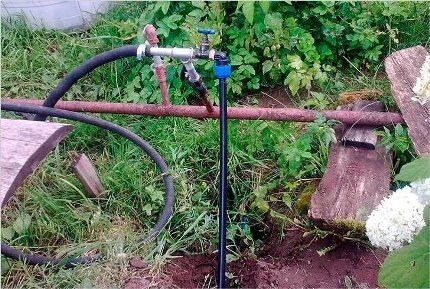
Often the irrigation system is installed in the ground. Digging it up for the winter means loading yourself with additional work. Usually it is preserved and remains in the ground. But plastic becomes brittle in cold weather, which often leads to its destruction.
And steel and copper can easily withstand negative temperatures. Pipes made from them can be safely left in the ground for the winter. You just need to drain the water from them before it gets cold.
With markings and assortment fittings for connecting steel pipes The following article will introduce you, which we recommend reading.
Review of polymer pipes for dachas
There are several types of plastic pipes, which differ greatly in characteristics. Some of them can be used for watering in the country all year round, while others can only be used in summer and autumn until frost. Some are recommended to be laid on the ground, while others should be buried in the ground to protect the pipeline from direct sunlight.
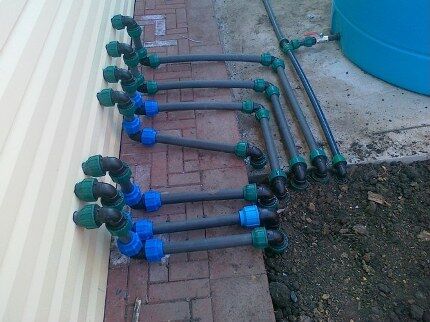
Assembling polymer pipes for watering an irrigation system in a dacha should not cause problems. It is possible to do everything yourself. Plastic is lightweight and easy to cut and join. It is only necessary to correctly draw up the pipeline diagram, accurately calculating the required number of fittings and the footage of pipe products.
Option #1: Polyethylene (PE)
The first in terms of polarity and durability are pipes made of low-density polyethylene (HDPE). The term "low pressure" here refers to the manufacturing technology of the plastic product, not the performance characteristics of the pipeline. PE is quite suitable not only for low-pressure country water supply, but is also widely used in the installation of heating and hot water systems.
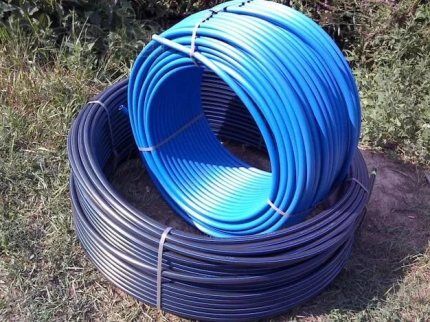
In stores you can find products made of cross-linked polyethylene labeled PEX. Such pipes have higher strength characteristics, but also a higher price. It is not advisable to purchase them for irrigation water supply in a dacha. There are cheaper analogues that can cope with the task of supplying water for watering the garden without any problems.
Compared to other plastic pipes, polyethylene pipes are more:
- flexible and elastic;
- resistant to ice formation inside (does not break);
- resistant to tearing and bending;
- roads.
Operating temperature of polyethylene pipes – from -70 to +800S. They are not afraid of frost. The irrigation system made from them will easily overwinter in the ground, and in the spring it will begin to work without any problems or additional tricks.
HDPE pipes are connected by welding and using fittings. You should not use the first method at the dacha.In this case, the irrigation system turns out to be non-separable. Plus, for the work you will need to buy or rent a special soldering iron, which will cost you extra money. This option is more suitable for indoor water supply systems. It is better to use compression fittings.
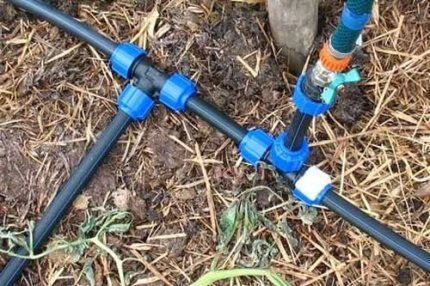
Another plus in favor of choosing polyethylene pipes for organizing irrigation at your dacha is their resistance to ultraviolet radiation. A surface watering system can be made from them by laying it on the soil.
The walls of PE pipelines will not collapse under the sun. The same cannot be said about other polymer pipelines. They are not at all friendly with ultraviolet rays.
Option #2: Polypropylene (PP)
Compared to the first option, polypropylene pipes are more resistant to high temperatures, but do not tolerate cold well. They are mainly used for heating systems. But they are also quite suitable for watering the garden.
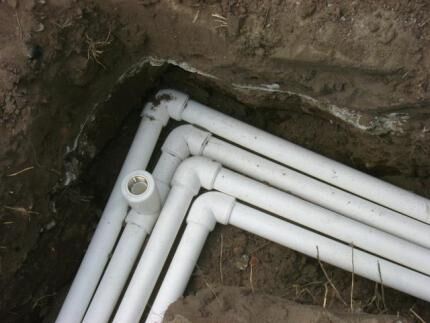
More often PP pipes are connected with fittings, produced for soldering or cold welding. To do this, their ends are heated to 260 degrees so that the polymer begins to melt, and then the connecting part is inserted. After cooling, such a joint turns into a monolith that is difficult to break.
The garden irrigation system made of polypropylene pipes is a non-separable type.And given that this plastic is not afraid of ultraviolet radiation, especially black products with enhanced UV protection, it also does not need to be buried in the ground or protected from the sun.
Plus, the use of fittings and diffuse soldering technology complicates installation work. Polypropylene is not the easiest and most convenient option for a summer residence.
In terms of cost, PP pipes are inferior to their polyethylene counterparts. However, fittings for it (tees, transitions, turns) are several times cheaper than those needed to connect PE products. On the other hand, polypropylene pipelines are more durable. Being in the ground, they are able to withstand the weight of a person and not break.
Option #3: Polyvinyl chloride (PVC)
The cheapest option is polyvinyl chloride (PVC). These pipes are characterized by low resistance to ultraviolet radiation. But you shouldn’t leave them in the sun for long. Frosts are not as bad for them as for polypropylene products. But at subzero temperatures they become more fragile and are easily damaged by a slight blow.
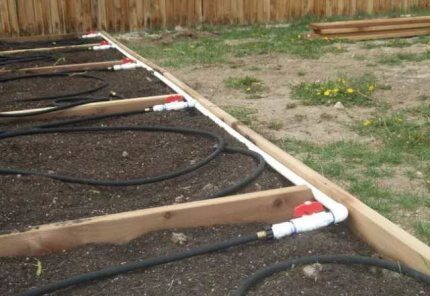
Fittings and special glue are used to connect the PVC pipeline. The general installation technology is comparable to the polypropylene version, only an adhesive composition is used instead of high temperature to soften the polymer. The resulting water conduit is non-separable.
If a polyvinyl chloride pipeline for watering a garden is not protected from the sun, it will not last long. With prolonged exposure to sunlight, photodegradation begins in this polymer compound. As a result, the product made from it becomes less durable and ductile. The walls of PVC water pipes are made harder and more fragile.
To install irrigation in a dacha, PVC pipes should be dark in color. They contain additives that increase UV resistance. And the sun does not directly affect the water in such a pipeline, which reduces the risk of algae growing inside.
Regardless of the type of polymer pipe chosen, self-watering from it can be done with your own hands. The main thing here is to weigh all the pros and cons of each plastic without exception. The cheapest option can be either the best investment or a waste of money.
If you make mistakes when choosing consumables and installation, your garden watering conduit will not last long.
Often the main line of such a pipeline is made of stainless steel, and the branches to the beds and trees are made of polymers in a detachable design. By winter, these polymer pipes can be removed and stored. Such a system will be the most durable and reliable.
Conclusions and useful video on the topic
The following videos will help you navigate the different types of polymer pipes, which are most often used when installing automatic and semi-automatic irrigation systems in the country.
Video #1. Organizing drip irrigation in the garden with your own hands:
Video #2. Technology for installing a polymer water supply for irrigating garden beds:
Video #3. Details about polyethylene water pipes:
It takes very little time to set up watering in a country garden. But how much effort will be saved. Pipes for such a system can be used both metal and plastic.
Their choice largely depends on the soil moisture technology. Making holes for irrigation in a steel product is still a pleasure. Of the polymer products, polyethylene will last the longest. But if low cost of execution is at the forefront, then PVC is worth choosing.
Tell us about how and from what pipes you assembled the irrigation system at your summer cottage. Perhaps you have information that will be useful to site visitors. Please write comments in the block below, ask questions, post photos on the topic of the article.




Parents live in a country house. As they age, it becomes more and more difficult for them to care for the vegetation of their land in the summer, so my husband made them a universal AUTO watering system.
To implement and operate this system, he used pipes (perforated), bubblers and droppers. Parents are very happy with this “service”; its appearance has made their work much easier; automatic watering has become a good helper. The only drawback is that it was a bit expensive.
I'm not a fan of plastic, and I don't like the modern tendency to replace everything and everywhere with polymers. But right here I am with both hands for plastic pipes, even though metal ones are attractive because they are stronger. I have polyethylene pipes on my property. Yes, they are more expensive than other plastic ones, but they are also more reliable. I have stepped on them more than once, nothing breaks there. And the car and pedestrian paths with the garden water supply do not intersect.
Watering through sprinklers really takes a toll on the family budget. Cucumbers and tomatoes turn out almost golden. Therefore, I watered my garden this way only one summer. I looked at the accounts and realized that the system needed to be changed. Now I have drip irrigation on my property. I rejected the option when pipes are buried in the soil - this perforation, according to reviews from friends, gets clogged quite often. Too much hassle for the sake of aesthetics.
And at the end of the season, I disassemble the entire system, wash it, dry it and put it away for storage until next spring. I don’t really understand what frosts that damage pipes are being written about here. How do you plow your gardens in the fall if the pipes remain on the plot?
As for how to plow a garden in the fall, when drip irrigation is installed, everything is simple - it needs to be dismantled. That is, I always install drip irrigation in such a way that at the end of the season it can be easily and quickly disassembled; I wrap the hoses on special reels, plus each hose is numbered.
But in a greenhouse it’s already simpler: most of it is installed permanently, but if necessary, the system can be easily upgraded or moved. I use an old cast iron bathtub (for greenhouses) as a container, and plastic ones for the garden - Eurocubes.
Yes, I also think that you can’t think of anything better than HDPE pipes for watering your garden. I am planning to make a drip irrigation system. The inconvenience is that water is provided in the village three days a week, so we collect it in a container. I'm not sure that it will be possible to water by gravity without a pump.